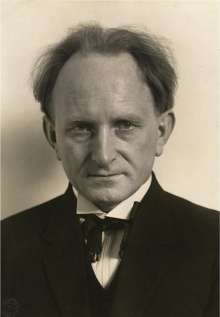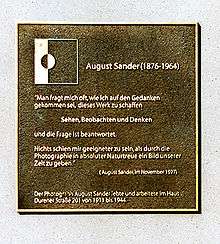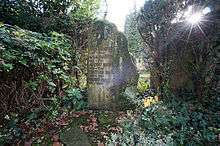August Sander
| August Sander | |
|---|---|
 | |
| Born |
17 November 1876 Herdorf, Rhine Province |
| Died |
20 April 1964 (aged 87) Cologne, West Germany |
| Nationality | German |
| Occupation | Photographer |
August Sander (17 November 1876 – 20 April 1964) was a German portrait and documentary photographer. Sander's first book Face of our Time (German: Antlitz der Zeit) was published in 1929. Sander has been described as "the most important German portrait photographer of the early twentieth century."[1]
Life
Sander was born in Herdorf, the son of a carpenter working in the mining industry. While working at a local mine, Sander first learned about photography by assisting a photographer who was working for a mining company. With financial support from his uncle, he bought photographic equipment and set up his own darkroom.
He spent his military service (1897–99) as a photographer's assistant and the next years wandering across Germany. In 1901, he started working for a photo studio in Linz, Austria, eventually becoming a partner (1902), and then its sole proprietor (1904). He left Linz at the end of 1909 and set up a new studio in Cologne.
In 1911, Sander began with the first series of portraits for his work People of the 20th Century. In the early 1920s, he came in contact with the (Cologne Progressives) a radical group of artists linked to the workers' movement which, as Wieland Schmied put it, "sought to combine constructivism and objectivity, geometry and object, the general and the particular, avant-garde conviction and political engagement, and which perhaps approximated most to the forward looking of New Objectivity [...] ".[2] In 1927, Sander and writer Ludwig Mathar travelled through Sardinia for three months, where he took around 500 photographs. However, a planned book detailing his travels was not completed.
Sander's Face of our Time was published in 1929. It contains a selection of 60 portraits from his series People of the 20th Century, and is introduced by an essay by Alfred Döblin titled "On Faces, Pictures, and their Truth." Under the Nazi regime, his work and personal life were greatly constrained. His son Erich, who was a member of the left wing Socialist Workers' Party (SAP), was arrested in 1934 and sentenced to 10 years in prison, where he died in 1944, shortly before the end of his sentence. Sander's book Face of our Time was seized in 1936 and the photographic plates destroyed. Around 1942, during World War II, he left Cologne and moved to a rural area, allowing him to save most of his negatives. His studio was destroyed in a 1944 bombing raid. Thirty thousand of Sander's roughly forty-thousand negatives survived the war, only to perish in an accidental fire in Cologne in 1946. Sander practically ceased to work as a photographer after World War II. He died in Cologne in 1964.


Legacy
His work includes landscape, nature, architecture, and street photography, but he is best known for his portraits, as exemplified by his series People of the 20th Century. In this series, he aims to show a cross-section of society during the Weimar Republic. The series is divided into seven sections: The Farmer, The Skilled Tradesman, Woman, Classes and Professions, The Artists, The City, and The Last People (homeless persons, veterans, etc.). By 1945, Sander's archive included over 40,000 images.
In 2002, the August Sander Archive and scholar Susanne Lange published a seven-volume collection comprising some 650 of Sander's photographs, August Sander: People of the 20th Century. In 2008, the Mercury crater Sander was named after him.[3]
Exhibitions
- August Sander, People of the 20th Century, São Paulo Bienal, Brazil
- August Sander: um Bonn, Feroz Galerie, Bonn Germany, November 23, 2012 - January 18, 2013
- Portrait.Landscape.Architecture Multimedia Art Museum Moscow, Moscow Russia, January 21 - June 21, 2013
References
| Wikimedia Commons has media related to August Sander. |
- ↑ Michael Collins, Record Pictures (Thomas Telford Publishing, 2004), p. 1842
- ↑ Wieland Schmied: "Neue Sachlichkeit. Der deutsche Realismus der zwanziger Jahre", in: Kritische Grafik in der Weimarer Zeit, Op. cit., p. 21. As cited in: August Sander 1876–1964. Lange, Susanne, p. 108. ISBN 3-8228-7179-6
- ↑ "Mercury Features Receive New Names" Archived 2016-09-13 at the Wayback Machine. by Paulette Cambell, press release Applied Physics Laboratory, Johns Hopkins University (28 April 2008)
Further reading
- Gerhard Sander, Susanne Lange and Gabrielle Conrath-Scholl, August Sander: People of the 20th Century, 7 vols, 2002, Harry N. Abrams.